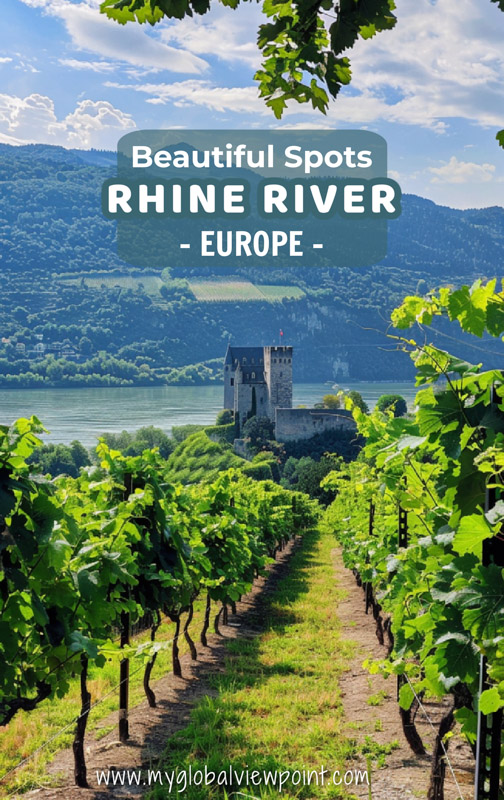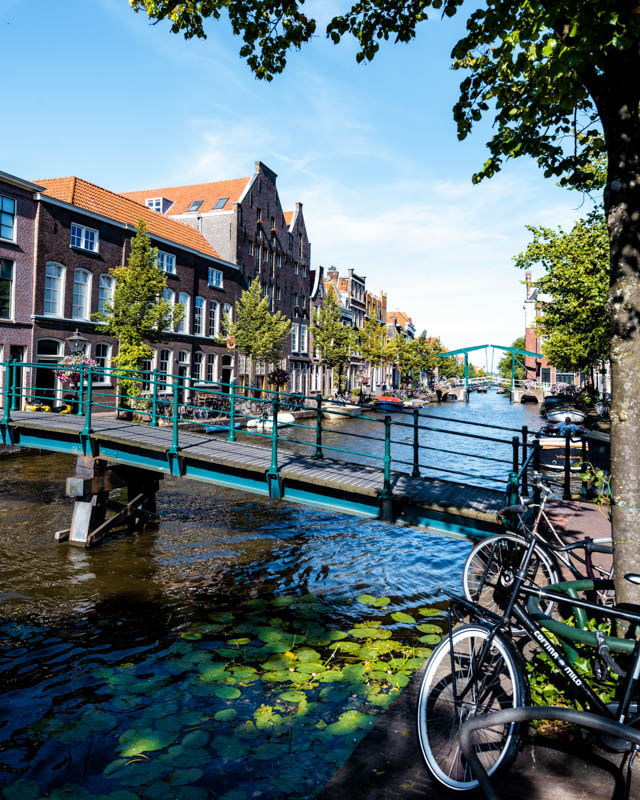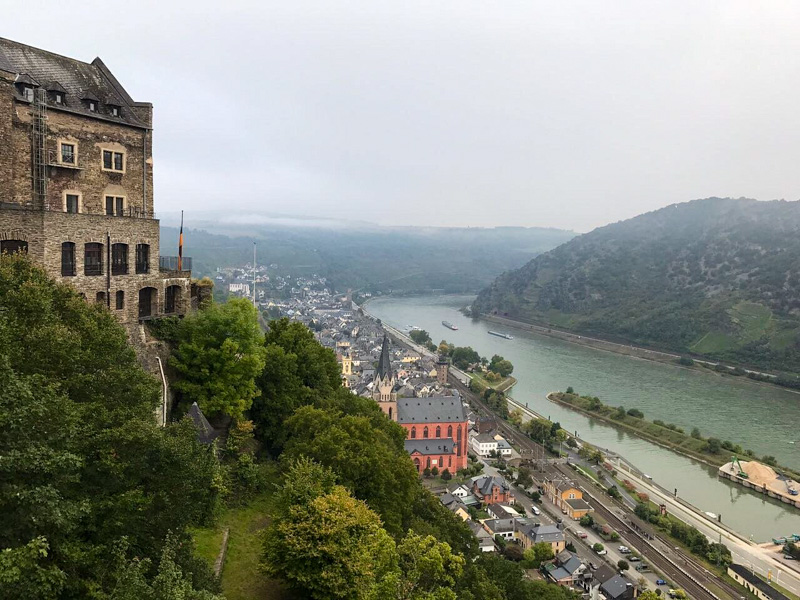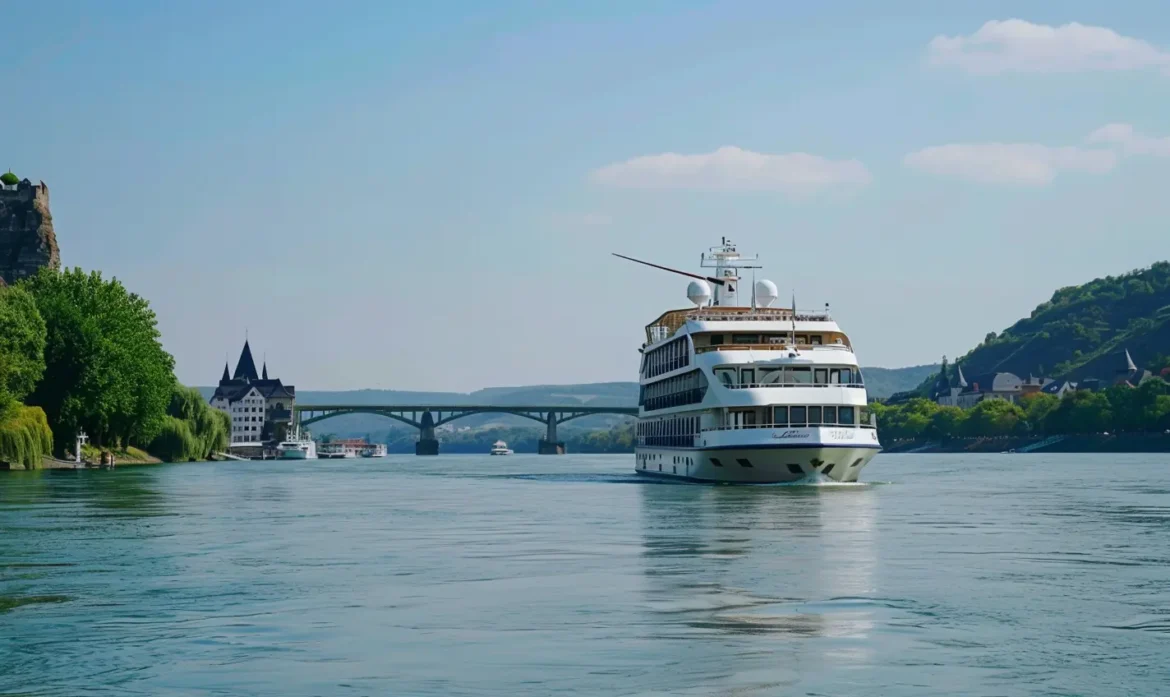The Rhine River completely changed my view of European travel. Every time I think about cruising past those medieval castles perched on cliffs, I get goosebumps. When I stood at the top of Marksburg Castle watching boats glide by below or sipped Riesling in a 400-year-old wine cellar in Rüdesheim, I realized this wasn’t just another river. This was pure magic.
From Switzerland to the Netherlands, these are the most beautiful places on the Rhine River that will make your jaw drop. Through ancient vineyards, charming villages, and UNESCO sites that look straight out of a fairytale, let me show you my 13 favorite spots along this legendary waterway. Get ready to fall in love with one of Europe’s most incredible rivers!
Must-See Destinations on the Rhine River
Looking to explore the Rhine River’s most beautiful places? From the stunning castles of the Middle Rhine Valley to the vibrant city life of Cologne, the Rhine River is packed with stunning scenery. Stroll through the historic streets of Heidelberg, marvel at the natural beauty of the Lorelei Rock, or explore the charming town of Bacharach. Discover the tranquil allure of Rüdesheim, the picturesque landscapes of Koblenz, or the cultural richness of Strasbourg. Whether you’re into castles, history, or scenic cruises, here are 12 of the Rhine River’s most breathtaking spots!

1. Bingen, Germany
Bingen sits perfectly where the Rhine meets the Nahe River, and honestly, I think it’s one of Germany’s most underrated wine towns. The Burg Klopp castle ruins offer killer views that’ll make your Instagram followers actually jealous – you can climb the tower for free, and the sunset shots from up there are incredible. I spent an entire afternoon wandering through the riverside gardens and community spaces they’ve built along the waterfront, which feels way more authentic than the touristy spots downstream.
The Mäuseturm (Mouse Tower) on its tiny island has this crazy legend about a cruel bishop being eaten alive by mice – the local guides love telling this story, and it’s actually pretty entertaining. The Museum am Strom downtown gives you solid background on 2,000 years of Rhine history if you’re into that stuff. Wine lovers shouldn’t miss the family-run cellars where you can taste crisp Rieslings that cost half what they do in Rüdesheim. The old crane from 1487 still stands by the harbor – it’s basically a medieval forklift that two guys had to power by running inside a giant hamster wheel. Don’t skip the St. Rochuskapelle if you’re driving up the hill; the views back down to the Rhine bend are worth the detour.

2. Black Forest, Germany
The Black Forest isn’t just about cuckoo clocks and cake anymore – though both are still awesome. I’ve hiked sections of the Westweg trail, and the dense pine forests really do feel like you’re walking through a Brothers Grimm story. Triberg Falls remains Germany’s highest waterfall at 163 meters, and the trails are well-maintained with multiple viewing platforms. The Schwarzwaldhochstraße scenic drive gives you epic valley views without breaking a sweat, especially around Mummelsee where you can grab lunch with mountain views.
Baden-Baden still has those Roman hot springs, but now they’ve got modern spa facilities that don’t feel stuffy. The Black Forest National Park near Freudenstadt has excellent hiking trails that range from easy family walks to serious mountain bike routes. I tried the Gipfeltrail on an e-bike – trust me, you’ll want electric assist for those climbs. The traditional workshops in Triberg still hand-carve cuckoo clocks using centuries-old techniques, and watching the craftsmen work is pretty mesmerizing. Titisee and Schluchsee offer water activities if you want a break from hiking. The Black Forest Line Cable Bridge near Bad Wildbad has hiking trails and a suspension bridge that tests your fear of heights – entry is around €6 for adults.
- Read next: Cheapest Airports to Fly Into Germany

3. Boppard, Germany
Boppard sits on the Rhine’s most dramatic horseshoe bend, and the chairlift up to Gedeonseck is honestly one of the best value experiences on the entire Rhine. At €12 for a round-trip ticket (2025 prices), the Sesselbahn takes about 20 minutes each way and delivers you to viewpoints that make the touristy castle cruises look boring. The Gedeonseck restaurant at the top is cash-only but serves decent food with million-dollar views of the river bend below.
I walked the extra 10 minutes to Vierseenblick (Four Lakes View), where the Rhine’s curves create the optical illusion of separate lakes – it’s one of those photos that looks almost too good to be real. The chairlift operates daily from 10am-6pm during peak season, and the older-style chairs move slowly enough that even nervous riders can handle it. Down in town, the riverside promenade has excellent restaurants where you can watch river traffic while eating local Riesling and schnitzel. The medieval streets have well-preserved Roman walls and half-timbered houses that photograph beautifully during golden hour. Boppard gets way fewer crowds than nearby Rüdesheim, so you can actually enjoy dinner without fighting for tables.

4. Leiden, Netherlands
Leiden is basically Amsterdam without the chaos, and I wish more people knew about it. Canal cruises run daily from 10am-4pm with Rederij Rembrandt (€14.50 for adults in 2025), and their 55-minute tours hit all the major sights with multilingual headphones. The Young Rembrandt Studio at Langebrug 89 offers a cool 7-minute 3D experience showing where the artist learned his craft – it’s small but well-done and costs around €5.
The Hortus Botanicus botanical garden has incredible tulip displays in spring and exotic plants year-round in heated greenhouses. De Valk windmill is climbable and gives you great views over the red-tiled rooftops, though honestly the exterior photos are better than the interior tour. I loved wandering the narrow streets around Leiden University – it’s got that perfect college town energy with excellent cafes and bookshops. The Rembrandt Route walking tour (€6.95 from tourist office) takes you to all his childhood haunts with AR elements if you download their app. Leiden works perfectly as a day trip from Amsterdam (35 minutes by train), and the crowds are totally manageable even during tulip season. The Saturday market in Beestenmarkt has great local cheese and stroopwafels.

5. Braubach, Germany
Braubach exists purely to serve Marksburg Castle, but honestly, that’s enough. This perfectly preserved medieval fortress is the only hilltop castle along the Rhine that was never destroyed, so everything you see is genuinely 700 years old. The 45-minute guided tours (€8 adults, €4 kids) take you through authentic knight’s halls, kitchens, and armories that feel like movie sets.
I hiked up the steep path from town in about 15 minutes – it’s a decent workout but saves you the tourist bus ride. The views from the castle walls over the Rhine valley are spectacular, especially late afternoon when the light hits the river perfectly. Down in Braubach’s old town, the narrow cobblestone alleys and half-timbered houses create an incredibly photogenic maze. The RheinBurgenWeg hiking trail passes right through town if you want to extend your visit with serious walking. Several traditional wine taverns serve local Riesling and hearty German food – Gasthaus zur Marksburg has the best atmosphere and castle views from their terrace. The combination of authentic medieval history and stunning river valley scenery makes this stop totally worth the small detour from the main Rhine cruise routes.

6. Ehrenbreitstein Fortress, Germany
Ehrenbreitstein Fortress towers 118 meters above Koblenz, and the cable car ride across the Rhine is half the fun. The Seilbahn Koblenz operates daily 10am-7pm with Germany’s highest transport capacity (7,600 people per hour), so you rarely wait long. Combo tickets including fortress entry cost around €21.90 for adults, and honestly, it’s worth every euro for the panoramic views.
The fortress itself is Europe’s second-largest preserved fortress, rebuilt between 1817-1828 after Napoleon blew up the original. The museums inside cover military history, archaeology, and regional culture with interactive exhibits that don’t put you to sleep. I spent most of my time on the outdoor terraces photographing the confluence of the Rhine and Moselle rivers – the perspective is absolutely unbeatable. The fortress grounds have several restaurants and cafes, plus a beer garden that’s perfect for sunset drinks.
The cable car ride takes about 8 minutes each way and gives you bird’s-eye views of Deutsches Eck below. Kids under 7 ride free on both the cable car and fortress entry. The fortress has excellent accessibility with ramps and elevators throughout – unusual for a historic building this old. Plan at least 2-3 hours total between the cable car rides, fortress exploration, and inevitable photo sessions. The views back toward Koblenz’s old town and the river junction are genuinely spectacular from up here.

7. Basel, Switzerland
Basel has this unique summer tradition of swimming in the Rhine that you absolutely have to try. The water’s surprisingly clean and refreshing (20-24°C in summer), and floating downstream with the current through the historic old town is an experience you won’t find anywhere else. The Wickelfisch waterproof bags (available at tourist offices for around €18) keep your clothes dry while doubling as flotation devices.
The best entry point is near Museum Tinguely – from there you can float 3 kilometers downstream past medieval buildings and modern architecture. Every Tuesday in July-August, trained lifeguards offer free guided swims starting at 5:45pm (book ahead). The Kunstmuseum Basel houses one of Europe’s premier art collections, and the red sandstone Basel Münster cathedral offers great views from its towers. The old town’s narrow streets reveal centuries of history, with Marktplatz and its colorful town hall being Instagram gold.
Art Basel in June transforms the city into the international art world’s epicenter – if you’re visiting during the fair, book accommodations way in advance. The Rhine ferries provide a charming way to cross the river using historic cable systems. Basel sits at the intersection of Switzerland, France, and Germany, making it perfect for day trips in three countries. Summer temperatures regularly hit 25-30°C, making Rhine swimming absolutely perfect for cooling off after museum visits.
- Read Next: Unique Restaurants in Basel, Switzerland

8. Koblenz, Germany
Koblenz sits at one of Europe’s most dramatic river confluences, where the Rhine and Moselle create the famous Deutsches Eck. The cable car up to Ehrenbreitstein Fortress (€21.90 combo ticket) provides the money shot – that perfect aerial view of two mighty rivers converging that makes all the tourism brochures. I’ve taken this ride multiple times, and it never gets old watching boats navigate the junction 118 meters below.
The fortress itself took 11 years to build (1817-1828) and now houses excellent museums covering 2,000 years of regional history. The interactive exhibits and authentic period rooms bring military history to life without being boring. Down in Koblenz’s old town, the Schängelbrunnen fountain embodies local humor – the cheeky boy figure spits water at unsuspecting tourists every few minutes. The Basilika St. Kastor dates back 1,000 years and anchors the historic center beautifully.
Koblenz works perfectly as a base for exploring the Middle Rhine Valley – you can day-trip to Rüdesheim, Boppard, or Bacharach easily. The riverside promenades have excellent restaurants with outdoor seating overlooking river traffic. Wine taverns serve both Rhine and Moselle varieties since you’re literally at the intersection of both wine regions. The Rhein in Flammen fireworks festival happens annually in August with synchronized displays along multiple river cities.

9. Petite France in Strasbourg, France
Petite France is pure Alsatian fairy tale – half-timbered houses with flower boxes reflecting perfectly in quiet canals. The Covered Bridges and Barrage Vauban create picture-perfect viewpoints that look straight out of a medieval storybook. I always recommend visiting late afternoon when tour groups leave and the warm light makes those colorful facades absolutely glow.
The Batorama boat tours (€14.70 adults, 70 minutes) glide under low bridges and past waterfront restaurants where you can hear multiple languages at neighboring tables – the Alsatian blend of French and German culture is fascinating. The Tanner’s Quarter still has workshops where artisans practice traditional crafts, and the tiny streets reveal hidden courtyards perfect for photos. Restaurant am Pont du Corbeau has canal-side terraces where you can sample local Flammekueche and Riesling.
Walking the district takes about 2 hours if you really explore all the side streets and canals. The Strasbourg Cathedral is just a 10-minute walk from Petite France if you want to extend your visit. December’s Christmas Market transforms the area into a winter wonderland, but summer offers the best canal reflections and outdoor dining weather. The district showcases Alsace’s unique position between French and German cultures – you’ll hear both languages regularly and see architecture influenced by both traditions.
- Read next: Things to Do in Strasbourg France

10. Rhine Gorge, Germany
The Rhine Gorge between Bingen and Koblenz packs more castles per kilometer than anywhere else in Europe – over 40 hilltop fortresses in just 40 miles. KD Rhine Line cruises (€23.20 for the full stretch) provide the classic experience, with multilingual commentary about every castle, vineyard, and legend. The Lorelei Rock near St. Goar marks the gorge’s most dangerous bend, where the legendary siren supposedly lured sailors to their doom.
Marksburg Castle near Braubach is the only completely preserved hilltop castle – every other fortress was destroyed at some point and rebuilt. The Rheinsteig Trail offers hiking options from easy vineyard walks to challenging cliff-top scrambles with incredible valley views. I’ve hiked sections near Bacharach where the trail winds through terraced vineyards producing some of Germany’s finest Riesling.
The Rhine in Flames festivals happen throughout summer, with entire hillsides illuminated by fireworks reflecting off the water – absolutely magical. Bacharach and Oberwesel are the most photogenic medieval towns, with complete city walls and towers. River cruises run frequently March-October, and you can hop on/off at any town. The UNESCO World Heritage designation recognizes this as one of Europe’s most important cultural landscapes, where human settlement and natural beauty created something truly unique.

11. Rüdesheim, Germany
Rüdesheim is touristy for good reason – Drosselgasse really is one of Germany’s most atmospheric medieval streets. The narrow cobblestone lane pulses with live music from traditional wine taverns, and honestly, the energy is infectious even if it feels a bit theme-park-ish. I always grab a table at Weinstube Rüdesheimer Schloss for authentic Riesling and people-watching as tour groups flow past.
The cable car to Niederwalddenkmal (€7.50 round-trip) climbs through vineyard terraces to the massive Germania monument celebrating German unification. The views back down to the Rhine and across to the Rheingau vineyards are spectacular – definitely worth the short ride up. Rüdesheimer Kaffee is the local specialty: coffee with Asbach brandy, sugar, and whipped cream served in special glass cups. It’s touristy but delicious, and watching the theatrical preparation is half the fun.
The Rheingau Wine Trail connects multiple vintages if you want to escape Drosselgasse’s crowds. Siegfried’s Mechanical Music Cabinet houses an incredible collection of self-playing instruments – weird but fascinating for music lovers. The Christmas Market in December transforms the already-charming streets into pure winter magic. Yes, Rüdesheim gets crazy crowded during river cruise season (April-October), but there’s a reason everyone stops here – the combination of Rhine views, wine culture, and medieval atmosphere really is magical.

12. Schloss Drachenburg, Germany
Schloss Drachenburg is what happens when a wealthy 19th-century banker builds his dream fairy-tale castle – pure architectural fantasy overlooking the Rhine. The Drachenfels Railway (€12 round-trip), Germany’s oldest cog railway, carries you up the steep hillside past the Seven Hills that inspired Wagner’s Ring cycle. The castle’s neo-Gothic interiors feature elaborate wood carvings, stained glass, and period furnishings that feel like movie sets.
I climbed the extra 15 minutes to the Drachenfels ruins at the summit – medieval stones scattered across the hilltop with panoramic views of the Rhine Valley and distant Cologne Cathedral. The Schloss gardens are beautifully maintained with terraced levels, fountains, and viewpoints perfect for photos. Königswinter at the base makes a charming lunch stop with traditional restaurants and river views.
The combination of fantasy architecture, scenic railway ride, and Rhine valley views makes this a perfect half-day trip from Cologne or Koblenz. Entry to the castle costs €8 for adults, and guided tours reveal the fascinating story of Baron von Sarter, who built this palace but rarely lived in it. The Sea Life aquarium and Reptilarium at the base cater to families, while the Dragon Hall restaurant inside the castle offers formal dining with castle views. Plan 3-4 hours total including the train ride, castle tour, and hilltop hiking.

13. Stolzenfels Castle, Germany
Stolzenfels Castle represents 19th-century Romanticism at its finest – King Friedrich Wilhelm IV reconstructed this medieval ruin into his ideal summer palace. The neo-Gothic interiors showcase royal apartments with incredible attention to detail: intricate ceiling paintings, carved furniture, and romantic views over the Rhine. The Knight’s Hall displays impressive weapons and armor collections, while the Small Knight’s Hall features some of the most beautiful ceiling art along the Rhine.
The English-style gardens cascade down the hillside in terraced levels with pergolas, fountains, and strategically placed viewpoints. I spent an hour just wandering the garden paths – each turn reveals new perspectives of the Rhine Gorge and Koblenz in the distance. The observation tower provides the ultimate photo opportunity, with panoramic views stretching for miles in both directions.
Guided tours (€8 adults, €5 concessions) run regularly March-November and take about 45 minutes to cover the main rooms. The castle’s location just south of Koblenz makes it an easy add-on to fortress visits or river cruises. The restoration was so successful that UNESCO recognized the entire Middle Rhine Valley as a World Heritage site partly based on castles like this. The combination of authentic medieval foundations with romantic 19th-century additions creates something uniquely beautiful – you’re seeing both genuine history and one king’s idealized vision of medieval life.



Pin it!



